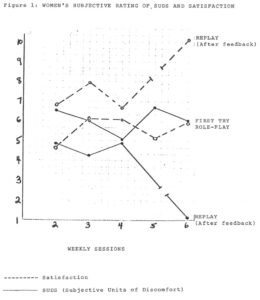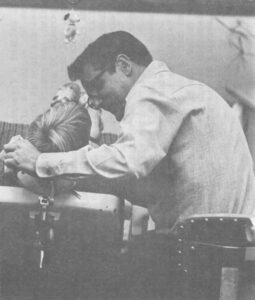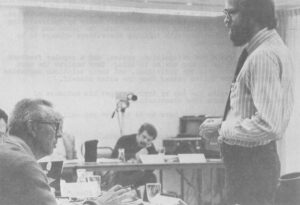Reston, Va. — A delicately assembled and highly unusual summit conference adjourned recently at this woodland conference center outside Washington. It was a conference made up of adversaries whose detente was so fragile and whose trust was so slight that their last common act was to vote to suppress any official version of what went on during the three days they met together.
The twin forces which drew this unconventional convention together were the rapidly expanding use of behavior control technologies in prisons and mental institutions, and the equally rapidly expanding interest of government and private groups in putting these technologies under restraints.
The participants, numbering nearly 100, represented interested parties — lawyers, policymakers, behavioral scientists, institution administrators and staff, and “consumers,” ex-prisoners and mental patients. Their viewpoints and interests diverged so widely that it often seemed that there were two conventions meeting in the same place — one to discuss the reform of institutions and another to discuss their abolition.
But they had agreed, under protocols worked out over a year, to talk, and the talk produced results which may bear importantly on the future both of American closed institutions and of applied behavioral science. 1
Despite their disagreements, the conferees shared a heavy sense of despair at the present state of prisons and mental institutions in the United States. “You are not surprised to find that the record is of high rhetoric and abysmally low performance,” said Dr. David J. Rothman, senior research associate at the Center for Policy Research at Columbia University, in his keynote speech. “Skepticism has never been so high.”
And Dr. Teodoro Ayllon, a widely known behaviorist and professor of psychology and special education at Georgia State University, lamented, “We have fallen on bad times, bad times.”
From comments gathered over the three days of the conference, June 13-15, the “bad times” amount to this: American prisons and mental institutions are at a crossroads. They are too large, there are too many of them, they are too costly, they are notorious for inhuman abuses, and most of all they are bankrupt in terms of working for anybody — the people who inhabit them, the professionals who staff them, or the society which supports them. Pressure for performance is high, yet cynicism over “rehabilitation” as an institutional goal is equally high. Something has to give — but what?
Here is where new technologies of behavior control take on importance. “If we are running the danger of reviving the rehabilitation ethic, it will come through the behavior modifier,” Rothman said. “Behavior modification holds out a number of attractions for a group convinced that nothing is now working. 2
“Behavior modification is closet punishment unrestrained by law,” warned psychologist Edward M. Opton Jr., dean of the graduate school at the Wright Institute in Berkeley, California. “Our institutions are festering sores on the body politic. They stink; it’s the smell of the absolute corruption of power. But in the jargon of behavior modification the stench of these festering sores is the sweet perfume of positive and negative reinforcement doing their job. 3
There was considerable fear, then, that behavior modification would become the latest lifeboat for institutions that have long deserved to sink. There was also apprehension directed toward behavior modification technology itself. What are these technologies which mother such contention?
The conference could not agree on the scope of “behavior modification,” but laymen’s explanations usually divide modern behavior control technology into two groups: biomedical techniques and psychological conditioning techniques.
Chief among the biomedical techniques are psychosurgery (for example, lobotomies), psychopharmacology (the use of mind-altering or mood-altering drugs), electroconvulsive therapy or ECT (shock treatments), and electronic stimulation of the brain or ESB (the implantation of electrodes in the brain to regulate behavior).
The term “behavior modification” is usually reserved for psychological conditioning techniques which include “applied behavior analysis” and “behavior therapy.” Behavior therapy deals with internal states such as fear and anxiety, as well as observable behavior. Applied behavior analysis, the child of psychologist B.F. Skinner, recognizes no such internal states and deals only with observable behavior, often in groups.
Both conditioning techniques share an approach to human behavior that stresses systematic reward and punishment as the key to behavior change. It is the ability of total institutions like prisons and mental hospitals to deliver just such systematic rewards and punishments that makes the behavioral approach so attractive to them, and also what makes it so horrifying to their critics.
Total institutions can reward their inmates not only with praise but with many basic necessities and amenities for living — money, plain or varied meals, permission to enjoy social life and recreation, and a host of other small freedoms. Institutions can also deprive inmates of these things and in addition submit them to “aversive,” or painful, techniques. (Examples have included shocks, and drugs which induce prolonged vomiting or the experience of drowning).
It is these kinds of tactics employed as therapy which have stirred public and legal debate. It was this debate, along with what one conference workshop agreed was a “quantum leap in the technology,” that produced the National Conference on Behavioral Issues in Closed Institutions at Reston. 4
The Abolitionist Offensive
A coalition of mental patients’ and prisoners’ rights groups, together with civil liberties lawyers and others, pushed hard at the conference to persuade the rest that the regulation of behavior technology is hopeless in coercive institutions and that, moreover, progress in corrections and mental health requires nothing less than the destruction of the institutions themselves.
“Total institutions crush the spirit, break the spirit, “argued Edward Opton. “It’s in their nature to do so. This is not because wardens and guards are sadists, though some are, but because they must do so…. Total institutions are places of great pressure and strain,” he continued. “The administration must use social and psychological strategies to hold them together.”
Among the strategies he listed were indeterminism (holding people for an indefinite time), rewards and punishments (“the brutal treatment of a few serves as an example and an incentive to the remainder”), and “breaking the spirit and will” through “degrading initiation ceremonies, isolation from social supports, and proving to inmates that they can be made to behave as robots in the most intimate parts of their lives.”
“Every tool of social and psychological power which could be turned to this purpose has been turned to this purpose,” Opton warned. “Any powerful technique which can be abused will be abused.” He made it clear that he is convinced behavior modification can and will be abused by institutions, and that the professionalism of behavior therapists is no deterrent to that abuse. “Environmental contingencies on administrators will require them to replace any behaviorists who fail to use their full power with more complaisant ones,” he said.
Janet Gotkin, a former mental patient and the founder of Mental Patients Resistance of Westchester County, N.Y., called behavior modification “the newest growth industry in the mental health field.” The questions surrounding it are not questions of technology, she said, but “questions of power — who should have it, and whether anyone should have the power to watch over another.”
“Mental hospitals are bins for society’s refuse — poor people, old people, children, women, the peculiar, the radical, the sad, the nonconforming, the eccentric. These human garbage dumps, masquerading as hospitals, are instruments for social control,” she asserted.
As for behaviorists’ offer of help, she was cynical. In her experience, she said, “the electroshocks, the restraints were called ‘help.’ It was always called ‘help.'” As for regulating behavior technology, she said: “Ideas of informed consent or free choice are laughably out of context in a mental hospital. It is impossible to implement any guideline truly protective of an incarcerated person.”
Gotkin attacked the conference as “self-serving,” concerned only “to better the condition of behavior modification, not to ask the question of whether there should be prisons or mental hospitals at all. The real question this conference is asking itself is, ‘What can we get away with as keepers? How far can we go?’”
Rudi Clemons, a black ex-prisoner, prison organizer, and project assistant for the National Prison Project in Washington, told the predominantly white audience that “you have as much chance of pulling off behavior modification programs in prison as you have of going back to England.”
“Time stops for a prisoner when he enters the gate and everything that goes on in there is meaningless,” Clemons said. “It is when he is released from the institution that time starts again. And when he is released the situation outside is the same as when he went in. The job market hasn’t improved. Opportunity hasn’t improved.”
Clemons suggested that behavioral scientists might best put their talents toward “constructing the type of environment that is an alternative to prison. You can’t make prisons better,” he said, “the only thing you can do is get rid of them.” 5
Dr. Peter Breggin, a young psychiatrist whose Maryland-based Center for the Study of Psychiatry has led a crusade against psychosurgery, made his point from the floor.
“Don’t you notice there’s something odd happening here?” he said. “Here are all these kind doctors offering people help and yet the very people they want to help are telling them they don’t want it. Why are the recipients of the services against the donors of the services?”
The answer, said Breggin, is in the answer to the question “Whose agent are you?”
“Conflict only enters when the behavior modifier enters as the agent of the institution,” Breggin said. “Whenever you have involuntary relationships you have an adversary system. The more involuntary the relations, the more adversarial the situation. In schools it’s the child vs. the teacher. In a prison it’s the prisoner against the administration. In a mental hospital the tension is nearly as great as in a concentration camp.”
Breggin urged his medical brethren to refuse to be the agent of any coercive institution, and received loud applause. At lunch, he said: “I’m getting a lot of well-wishinq from my fellow professionals, but nobody has come up to me and said, ‘Peter, I heard you and I’m breaking free.'”
Ground Rules for Policy: An Inventory of Suggestions
Despite the abolitionists’ strong pressures, the majority of people attending the conference were either unable or unwilling to buy the abolitionist argument, however much they sympathized with it. They seemed to feel that the destruction of prisons and mental institutions was not a viable option; or if it was, that it was not a desirable one; or that, even if the option was both viable and desirable, it would not leave them much to talk about. So the talk gravitated toward reform.
Discussion took place in small, private workshops. The workshops were numbered and there was no way to learn who was in which group. This was one of the many precautions taken to cool the political volatility of the conference and promote honest exchange. The numbered workshops were carefully mixed to include many viewpoints. (A second set of workshops for people with related backgrounds never took place.)
On the final day of the conference the chairmen and chairwomen of the workshops summarized the thinking of the groups before a general session. Some reports showed consensus; others were simply strings of statements presented without weight. But certain patterns emerged from the reports which showed the direction of thinking of key individuals in law, medicine, government, and community organization. Here are the chief points which emerged:
-
- Large institutions have basic flaws which must be eliminated before anything useful can be done.
One workshop put it this way: “On coercive institutions, we agreed that there are too many, they are too large, and they house certain residents quite inappropriately. The primary issue facing the nation in this area now is to attend to the size and the number and the inappropriate residents of these institutions. Insofar as behavior modification or any psychotherapy technique legitimizes the coercive institution as it now stands, extending its life as it now is, it may be that such legitimization procedures are categorically unwarranted.”
Another presentation said: “There was a very clear sense that by the time things get down to the so called ‘helpee’ they are very different from the problems conceived by the would-be ‘helper.’ There are real concerns that the brutality and atrocity and inhumanity that we all know about may not merely be occasional accidents and aberrations of a fundamentally benign system, but may be endemic to any total system. If that’s so, the present system may be so constructed that there is no such thing as voluntariness and no such thing as informed consent, and we may well be dealing with Frankenstein’s monster.”
- Large institutions have basic flaws which must be eliminated before anything useful can be done.
-
- Prisons and mental institutions, while similar, are not identical and require different policies.
The conferees had an easier time with prisons than with mental institutions, mainly because the issue of mental competence to make therapy choices was clearer. “Prisoners are competent to stand trial and be convicted and should be considered competent to make choices within prison programs,” one group leader explained. Another confessed that in his group “there was some feeling that the mental institution scene is harder and more complex to get a handle on. Its suppositions, the reasons you get there, aren’t quite as clear.”
- Prisons and mental institutions, while similar, are not identical and require different policies.
-
- Prisons should exist for public safety only and cease to justify themselves with claims to rehabilitation.
At least two workshops could report “that there will be a need for closed custody corrections” in the future. One group said that prisons should house only “dangerous individuals” and predicted that such a policy would reduce the present prison population to five percent of its current size. The other group refused to discuss “dangerousness” but left it simply that “if people are sent to institutions [it should be understood that] it is because society wants to send them there for the sake of society,” however well or poorly society defines its sake. “In other words,” the group said, “remove the rehabilitation treatment mythology.”
- Prisons should exist for public safety only and cease to justify themselves with claims to rehabilitation.
-
- Prison sentences should be short and fixed.
There was near-unanimous agreement at the conference that indeterminate sentences should be abolished and replaced by short, fixed, sentences. “Indeterminate sentences should be abolished because they preclude any voluntary participation in therapy,” one group reported. “Any program where there is an expectation of affecting your release date is inherently coercive and inherently useless.”
Another group reviewed a proposal that there be sentences of one, two, three, four, and eight years for various kinds of crimes, with the understanding that the terms were fixed and would be “without regard to what one did or how one behaved or what one’s progress was” in the institution.
Under such conditions, the group’s spokesman said, “an appropriately voluntary [behavior modification] program with appropriate safeguards might be tried, and at least if it failed one would have a clearer idea of why, and it would not have failed for many of the reasons which are of so much concern to us here.”
- Prison sentences should be short and fixed.
-
- A range of voluntary programs should be available, including programs generated by inmates.
Several workshops urged a variety of programs for institutions for inmates to choose from, but said that such programs should be “voluntary and independent of extraneous incentives such as money, privileges, or reduction of sentences.” Other suggestions were that inmates should have the right to create programs of their own, and that the focus of psychological programs should not be “on deviancy or curing deviancy, but on building coping skills in the same way that a person on the outside might seek the help of a therapist” to build such skills.
- A range of voluntary programs should be available, including programs generated by inmates.
-
- Prisoners and mental patients must have more power over their lives.
One idea mentioned several times was that prisoners and mental patients should be taught behavior modification techniques to use for “counter-control.” “If you believe that behavior modification is a powerful tool, and if you believe that power needs to be redistributed, then behavior modification should be taught to the oppressed so that they can better deal with an unfair world,” one report said.
The same report suggested that institution administrators might employ behavior systems from above “as a management control,” with goals and results posted openly. “For example, would it be useful to reward a guard on a cell — give him an additional $1,000 bonus — for each one of the inmates who graduates from his cell who is not arrested for a year?” the group conjectured.
The other major recommendation was the prisoners be given the right to organize. While there was no consensus, several groups reported “substantial agreement,” with practical reservations noted about how prisoner unions would work.
- Prisoners and mental patients must have more power over their lives.
-
- Human rights Committees and other regulatory mechanisms might do limited good.
The conference was generally skeptical about the promise of rules, guidelines, and procedural safeguards to govern behavior modification programs in closed institutions. A detailed proposal by Paul R. Friedman, managing attorney of the Mental Health Law Project in Washington, received wide discussion and some workshops recommended his model cautiously in their reports. 6
The most common safeguards urged for behavior programs were flat sentences; a ban on deprivations not needed for institutional security; and human rights committees to oversee behavior programs, set limits, and investigate complaints. One report included a proposal that such human rights committees be composed of elected inmates at prisons, parents of mentally retarded children at institutions for the mentally retarded, and patients or ex-patients at mental hospitals.
- Human rights Committees and other regulatory mechanisms might do limited good.
-
- Beyond the concern for inmates and institutions, there is a basic need to question what constitutes crime, deviance, and mental incompetence.
This was a conference of specialists, not philosophers, but there was a strong undercurrent of concern that the norms which cause people to be sent to prisons and mental institutions should not go unexamined.
One workshop report included the speculation that the preponderance of men in prisons might be explained by men’s tendency to “act out” in reaction to frustration, whereas the preponderance of women in mental institutions might be explained by women’s tendency to “internalize” their reactions to the frustrations of a sexist world.
Another concluded that closed institutions should be phased out and that “behavioral scientists should explore the larger policy issues and construct programs to confront them.” In this vein, Lennox S. Hinds of the National Conference of Black Lawyers asserted in a general session that “behaviorists and lawyers have a myopic view of what constitutes aberrant behavior.”
“I have some problems,” he said, “when I see the weight of the state being focused on person-to-person crime when nothing is being done on a global level where a policymaker sits and literally executes thousands of people.”
- Beyond the concern for inmates and institutions, there is a basic need to question what constitutes crime, deviance, and mental incompetence.
Cadenza: The Leak-proof Conference
During the first two days of the conference, radicals and the “establishment” maintained detente for the sake of exchange. The conference steering committee had tried to balance the representation both at the conference generally and in the mixed workshops. Everyone came with the condition that there were to be no votes, polls, or resolutions generated at the conference and that individuals could withdraw their names at any time.
For two days there was exchange. One chairman quipped that in his workshop “the lawyers were frustrated by the imprecision of the psychiatrists, the policymakers were frustrated by the consumers’ idealism, the consumers were frustrated by the psychiatrists’ denial of their own power, and the psychiatrists were glad that business was so good.”
On the third day, the conference collapsed into paranoia. After the morning’s business on June 15, attorney Edgar Brenner, director of the Behavior Law Center of the Institute for Behavioral Research, Inc., which sponsored the conference, rose to say that there had been some misunderstanding about the publication of official proceedings of the conference.
Despite contrary impressions, he said, there had always been plans to publish proceedings as an aid to policymakers. The steering committee knew of these plans, he said, and in fact the proceedings were required under the terms of the National Science Foundation grant which helped finance the conference and the expenses of everyone who attended it.
An uproar broke out. Its reason had been hinted at the day before in Paul Friedman’s address. “There was a suspicion among public interest lawyers,” he said, “that this conference would be cleverly devised to promote the behavior mod point of view.” Friedman was able to say then that those fears had proved unfounded. But now there was panic in the hall.
“We compromised ourselves by coming here at all and talking about closed institutions!” said a prisoners’ union representative, noting that the last time word of such collaboration got out “we were set back five years.”
“I came here with the assurance that I wouldn’t be legitimizing this conference in some future proceedings,” a woman said with some distress. “I never would have come if I’d known about this.”
Edward Opton felt double-crossed. “I was speaking to you as a highly sophisticated group, not a general public,” he complained. “I said things I wouldn’t say to the Washington Post or to Senator Kennedy’s committee if I were lobbying for a bill.”
Opton also complained that because he thought he was speaking off the record while others might have known they were speaking for the record, “an accurate record of the talks here won’t be accurate!” 7
Others expressed different concerns. One man said he was worried that official proceedings would “talk about inmates in impersonal terms” and fail to communicate “any sense of the human interest expressed here.” Several others feared that a compilation would come out sounding like mush, ignoring “the widely divergent points of view we have heard.”
The convention sponsors back pedalled quickly. Dr. H. McIlvaine Parsons, the kindly executive director of the Institute for Behavioral Research, Inc., said IBR had no funds for publication yet and the whole matter was up in the air. A representative from the National Science Foundation waived NSF’s requirement for proceedings on the spot.
An emergency session of the conference steering committee was called, and the committee quickly voted to suppress any publications except a list of topics discussed at the conference which would be distributed only to participants. 8
The speeches and results of workshops, a spokesman for the committee assured the conference, “will not be published to the world.”
End Notes
- The conference did not meet as a policy body but its discussions will certainly affect policy across the country. Most of the participants were highly placed, and those without titles played important roles in institutions and political organizations.
- A full version of Rothman’s talk, “Behavior Modification in Total Institutions: An Historical overview,” is published in The Hastings Center Report, Vol. 5, No. 1 (February 1975), available from the Institute of Society, Ethics and the Life Sciences, 623 Warburton Ave., Hastings-on-Hudson, N.Y. 10706.
- Opton’s formal remarks, together with the key papers presented on legal issues, are scheduled to be published in full in Vol. 17 No. 1 of the Arizon Law Review.
- A glossary of behavioral terms used in behavior modification, a behavior modification bibliography, and a listing of major court cases which may affect the use of behavior modification in prisons and mental institutions are available from the Behavior Law Center of the Institute for Behavioral Research, Inc., 2429 Linden Lane, Silver Spring, Md. 20910.
- Gotkin and Clemons respond to the argument for regulation in the Arizona Law Review issue mentioned in Note 3.
- Friedman’s plan is published in the Arizona Law Review, ibid.
- All of the information in this report was gathered at general sessions which were open to the press.
- Members of the steering committee were: Judith Areen, professor of law, Georgetown Law Center; Alvin J. Bronstein, executive director, National Prison Project, ACLU Foundation; Rudi Clemons, National Prison Project; Paul Friedman, managing attorney, Mental Health Law Project, ACLU Foundation; Dr, Joseph Perpich, senior professional associate, Institute of Medicine, National Academy of Sciences; Dr. Saleem Shah, chief, Center for Studies of Crime and Delinquency, National Institute of Mental Health; Herbert Silverberg, staff director, Commission on the Mentally Disabled, American Bar Association; Daniel L. Skoler, staff director, Commission on Correctional Facilities and Services, American Bar Association; and Serena Stier, Ph.D., administrative officer for policy studies, American Psychological Association.
Received in New York July 7, 1975
©1975 Ron McCrea
Ron McCrea is an Alicia Patterson Foundation award winner on leave from The Capital Times (Madison, Wisconsin). This article may be Published with credit to Mr. McCrea, The Capital Times, and the Alicia Patterson Foundation.





